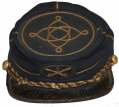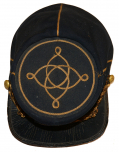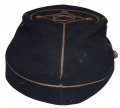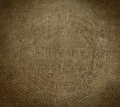site search
online catalog
INDIAN WAR PERIOD FIRST CAVALRY LIEUTENANT’S KEPI
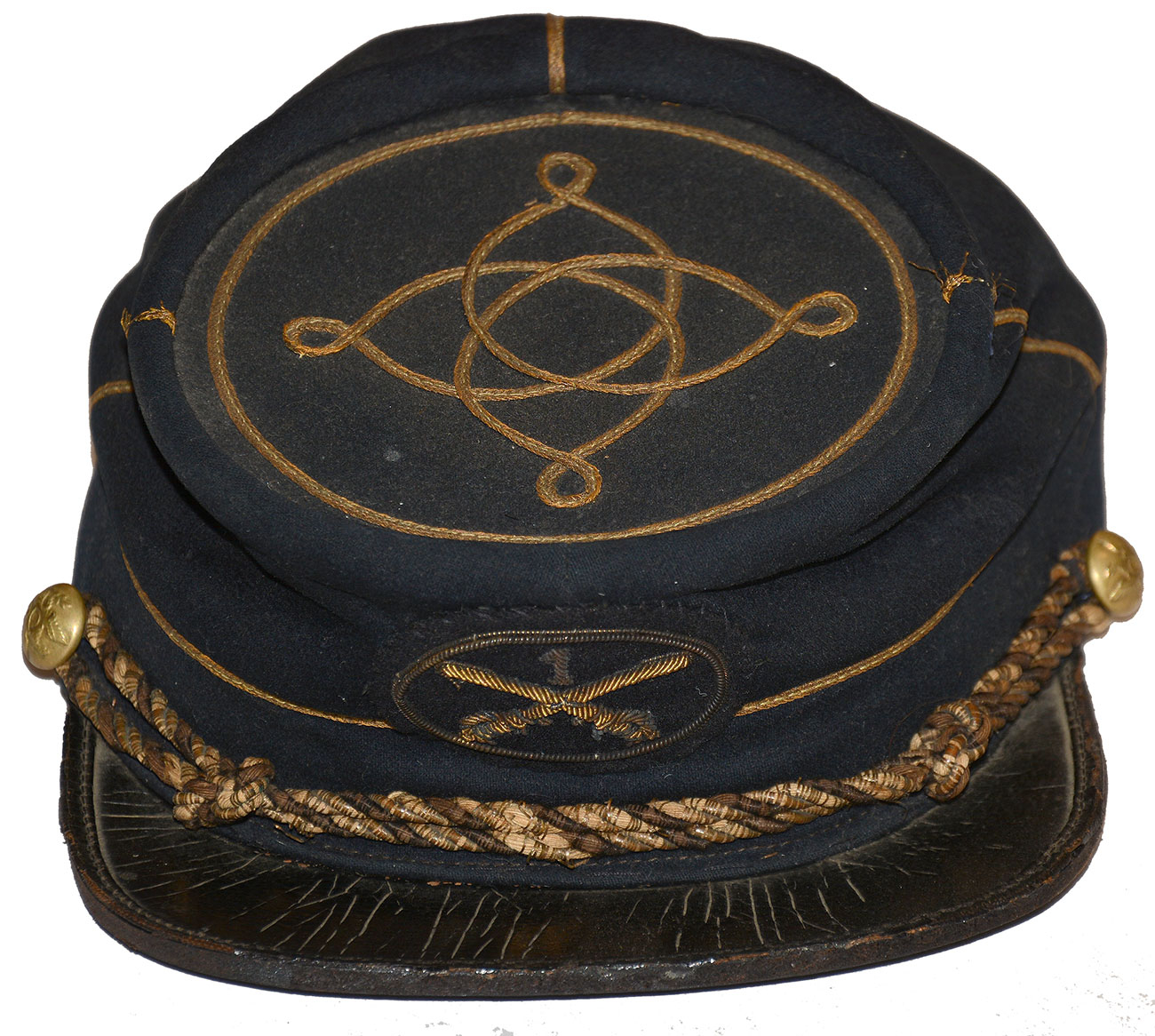
$1,250.00 SOLD
Quantity Available: None
Item Code: 1179-355
This is an excellent example of an officer’s kepi of the Indian War period. This follows the 1872 pattern, a descendent of the low-crown chasseur style kepis that became popular among officers in the Civil War. These are characterized by a lower crown with an inset top and a flat visor, which give them a trimmer and much nattier appearance. This one has a rise of 2 ¾ inches from the top of the visor in front and about 3 ¾ inches in a straight line up from the lower edge of the cap to the rear of top, measuring just behind the side button.
The fabric has excellent dark blue color, just some dust and slight fading on the crown, one or two small light stains, and no moth damage. A single strand of flat gold braid cord circles the top of the band around the bottom of the cap, and runs up the sides, front and back. The perimeter of the inset top has a similar single strand, and another forms a quatrefoil at center. The braid is in good condition, with a muted gold tone, and showing just a bit of wear on other side as is comes over the upper edge of the top- naturally a high point and most subject to contact in handling or storage. The single strand would denote a lieutenant.
Sewn to the front of the cap is an officer’s embroidered cap insignia consisting of a silvered numeral “1” over a pair of gilt crossed sabers on an oval patch with jaceron wire border, measuring about 2 ½ by 1 5/8 inches overall. The cap uses a braided chinstrap, or cap cord, secured by two small Eagle-C cavalry officer’s buttons at the sides. The cord is constructed of two gilt cords twisted with one black one, much like some Civil War officer’s hat cords. The black has oxidized to a brown and the thin gold used to create the gold cords is worn or missing in some places, showing the underlying cream-colored strands. These cords became regulation as of March 1, 1884, as a result of an 1883 request from the field noting that many officers were in fact wearing them. Indeed, Horstmann advertised them as early as 1877. The interior is fully lined in a heavy polished cotton. This shows one small hole over the wearer’s right eye and a rubbed maker or retailer’s mark embossed on the underside of the top that is faintly visible, but not legible. The sweatband is in place and a nice reddish brown in color, showing just minor wear and one slight tear on the wearer’s right rear. The visor is in place, but the stitching gave way along the edge of the cap body, exposing about 2 inches of the edge of the stiffener on one side and 1 inch on the other, and we see some restitching, but the visor seems stable and firmly attached.
This cap has a great eye-appeal and displays very nicely. It would fit well in a collection of U.S. army headgear, particularly that of the postwar frontier army. [sr] [ph:L]
~~~~~~~~~~~~~~~~~~~~~~~~~~~~~~~~~~~
THIS ITEM, AS WITH ALL OTHER ITEMS AVAILABLE ON OUR WEB SITE,
MAY BE PURCHASED THROUGH OUR LAYAWAY PROGRAM.
CLICK HERE FOR OUR POLICIES AND TERMS.
THANK YOU!
Inquire About INDIAN WAR PERIOD FIRST CAVALRY LIEUTENANT’S KEPI
For inquiries, please email us at [email protected]
Most Popular
Historical Firearms Stolen From The National Civil War Museum In Harrisburg, Pa »
Theft From Gravesite Of Gen. John Reynolds »
Selection Of Unframed Prints By Don Troiani »
Fine Condition Brass Infantry Bugle Insignia »
British Imported, Confederate Used Bayonet »
Scarce New Model 1865 Sharps Still In Percussion Near Factory New »
featured item
ENGRAVED GOLD 20th CONNECTICUT REGIMENTAL BADGE WITH BATTLE HONORS OF LT. OLIVER TAYLOR DOOLITTLE
This is a beautiful gold, engraved and identified regimental badge of the 20th Connecticut, which fought in the Army of the Potomac and Army of the Cumberland, seeing action at Chancellorsville, Gettysburg, the Atlanta Campaign, the March to the Sea,… (622-434). Learn More »
site search
Upcoming Events
May 16 - 18: N-SSA Spring Nationals, Fort Shenandoah, Winchester, VA Learn More »



